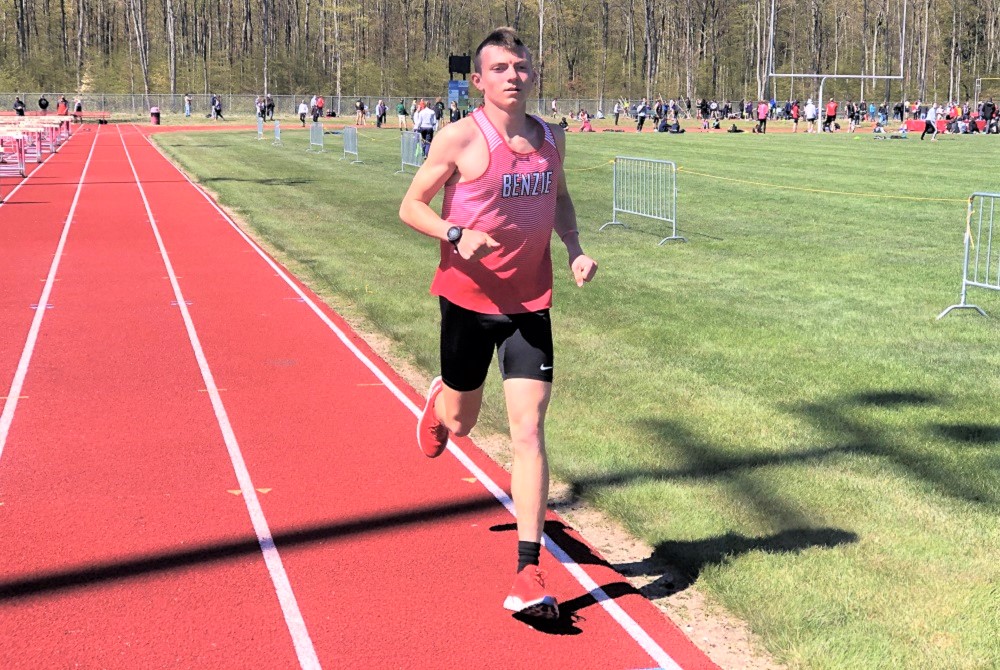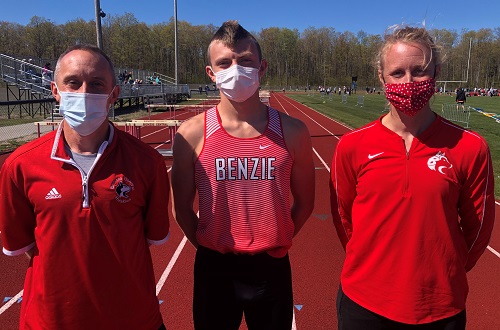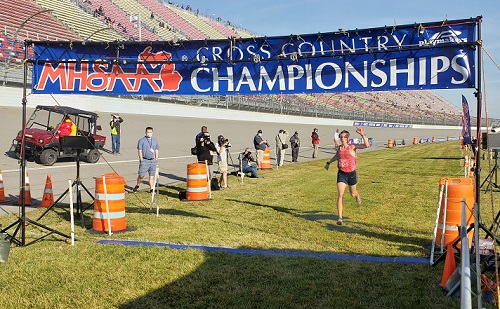
Benzie Phenom's Story Continuing to Unfold on Track
By
Tom Spencer
Special for MHSAA.com
May 14, 2021
As the phrase “history in the making” originated, someone simply had to know there would be a long-distance runner in Northern Michigan named Hunter Jones.
 Arguably, he is history in the making.
Arguably, he is history in the making.
And, track enthusiasts have a chance to preview some of the history the Benzie Central High School runner will make. Emphasis on will. He already has made history in so many ways.
He is only a sophomore. And, the history he makes will have at least one asterisk —for the 2020 Michigan high school track season that wasn’t.
The Benzie track team is offering its next preview glimpses of history-making Monday at the Titan Last Chance Meet at Traverse City West. The next opportunities after that will be on the Benzie track, during the Northwest Conference meet May 21 and the MHSAA Regionals on May 25.
This history-in-the-making story to watch over the next month is Jones’ likely accomplishment of winning his first MHSAA individual track championship June 5 at the Lower Peninsula Division 3 Finals at Jenison High School. Perhaps the only reason he hasn’t achieved that first title before is COVID-19 cancelled his freshman season.
Many onlookers believe Jones will do that in the 800. They also believe after re-hydrating, resting, stretching and foam rolling, he’ll hit the track again shortly after and win another state title in the 1,600.
And, they further believe, he’ll write even more history after a brief recovery to win the 3,200 and finish with three Finals championships in one day.
 Jones is preparing for the Finals by competing is all three of those events in the same day in the remaining meets. He and his coaches are challenging him by adding a 400 in all of those meets including the Finals.
Jones is preparing for the Finals by competing is all three of those events in the same day in the remaining meets. He and his coaches are challenging him by adding a 400 in all of those meets including the Finals.
He may run the 1,600 relay in the Finals should his team qualify. So four state championships are not out of the question. He tried the four events earlier this week and narrowly missed winning all four in an eight-team meet on Benzie’s track. He started the open 400 a bit slow and finished less than one second behind Kingsley’s Gage Hessem.
“I don’t know if anybody — I don’t know if I — truly, truly appreciate what this kid is,” acknowledged Asa Kelly, the Huskies’ longtime distance coach and a former college runner. “We knew he was going to be good for a long time, but how good is the question, right?
“We’ve had multiple state champions and loads of all-state kids, but nobody quite like him,” added Kelly, who has coached the boys cross country team to three Division 3 Finals titles. “He’s got this insatiable desire to win.”
At the age of 16, Jones is already in the history books. He owns school, meet and event records. He also has cross country course records. When he runs cross country in the fall, he’ll be pursuing a third Finals championship to go with his Lower Peninsula Division 3 titles won as a freshman and sophomore.
He is also a national champion. He won the sophomore division in the 3,200 of the National Scholastic Athletic Federation indoor track event in Virginia this spring.
“I want to be a state champion in at least three events,” Jones offered as one of his goals for his first track season. “It doesn’t matter what it is – at least three events.
“I have to run four events, so I think it will be challenging for me to go to each event and try to win,” he continued. “I think it is a good goal to try to win those.”
His others goals for this season? He wants to break the school records in the 800 and 1,600. He broke the school record in 3,200 last week in Farmington running an 8:59.
 Another of his Benzie coaches, Traci Knudsen Kelly, has no doubt Jones will he will win three Division 3 Finals championships this June. She should know. She competed in the Big Ten as a member of the Indiana University cross country, indoor and outdoor track teams after setting records and winning state titles in 400, 800 and 1,600 runs at Suttons Bay High School.
Another of his Benzie coaches, Traci Knudsen Kelly, has no doubt Jones will he will win three Division 3 Finals championships this June. She should know. She competed in the Big Ten as a member of the Indiana University cross country, indoor and outdoor track teams after setting records and winning state titles in 400, 800 and 1,600 runs at Suttons Bay High School.
“It’s a rare kid that comes along like him,” she noted. “I mean, I have never seen a high school kid like that.
“Between just the internal drive ... the will to win, the work ethic ... I mean, he’s the whole package.”
Jones’ brother Rick and sister Sarah are among the standouts in Benzie’s rich track and cross country past. Hunter recalls watching his siblings compete, and as he started running he was winning races as a second grader against fifth and sixth graders.
“I used to be deathly scared of racing, and I would almost cry before races,” Jones recalled. “It was weird going up against people that were like double my height.”
Not so anymore for the decorated runner whose future may not have any limits.
“The fact that he is sophomore is what a lot of people forget,” said Asa Kelly. “He is so young yet, and he’s got so much in front of him.”
Yup, history in the making.
 Tom Spencer is a longtime MHSAA-registered basketball and soccer official, and former softball and baseball official, and he also has coached in the northern Lower Peninsula area. He previously has written for the Saginaw News, Bay County Sports Page and Midland Daily News. He can be reached at [email protected] with story ideas for Manistee, Wexford, Missaukee, Roscommon, Ogemaw, Iosco, Alcona, Oscoda, Crawford, Kalkaska, Grand Traverse, Benzie, Leelanau, Antrim, Otsego, Montmorency, Alpena, Presque Isle, Cheboygan, Charlevoix and Emmet counties.
Tom Spencer is a longtime MHSAA-registered basketball and soccer official, and former softball and baseball official, and he also has coached in the northern Lower Peninsula area. He previously has written for the Saginaw News, Bay County Sports Page and Midland Daily News. He can be reached at [email protected] with story ideas for Manistee, Wexford, Missaukee, Roscommon, Ogemaw, Iosco, Alcona, Oscoda, Crawford, Kalkaska, Grand Traverse, Benzie, Leelanau, Antrim, Otsego, Montmorency, Alpena, Presque Isle, Cheboygan, Charlevoix and Emmet counties.
PHOTOS: (Top) Benzie Central’s Hunter Jones warms up during a track meet this season. (Middle) Jones, with Benzie coaches Asa Kelly, left, and Traci Knudsen Kelly. (Below) Jones crosses the finish line during the Cross Country Finals at Michigan International Speedway. (Track photos by Tom Spencer. Cross country photo courtesy of Benzie Central's cross country program.)

Hastings Relays Reigns as State's Oldest Continuous Track & Field Meet
By
Steve Vedder
Special for MHSAA.com
April 10, 2024
Bob Branch remembers dabbling in other sports, but his first love was always running.
 The Hastings High School graduate admits he could never hit a baseball, football didn't especially appeal to him and basketball was just another way to spend time with friends. But for Branch, now 93, there was always track. That's the sport where his fondest and sharpest memories remain. And if you're talking track, many of his favorite memories come from participation in the state's oldest continuous track meet, the Hastings Relays.
The Hastings High School graduate admits he could never hit a baseball, football didn't especially appeal to him and basketball was just another way to spend time with friends. But for Branch, now 93, there was always track. That's the sport where his fondest and sharpest memories remain. And if you're talking track, many of his favorite memories come from participation in the state's oldest continuous track meet, the Hastings Relays.
Always held in early April, the meet dates back to 1937 – a bygone time that saw the first hostilities of World War II, gas at 20 cents a gallon and a loaf of bread selling for a dime.
And at a dusty old track surrounding the county fairgrounds in Hastings, a small relay event that included a scattering of participants from a dozen high schools was taking its first tentative steps.
Branch recalls a time when kids would run home after track practice because there were no buses, inexperienced young coaches had little actual knowledge of running fundamentals, and athletes looked at the sport as an afterthought after spending most of their high school days playing football and basketball.
 For Branch, the relays were the ideal way to ease into the track season.
For Branch, the relays were the ideal way to ease into the track season.
"I just liked to run," said Branch. "I remember I anchored a relay with my brother, and it always seemed cold when we had that meet. I remember teams would come from all over and you saw a lot of good athletes. Everybody seemed to have someone who was really good. Track wasn't very popular at that time, but I have a lot of good memories from running."
The Hastings Relays, which has changed formats and even names during its nearly nine-decade history, would traditionally kick off the track season. The meet was originally held at a makeshift quarter-mile track which surrounded the town's fairgrounds and was part of the city's annual Hastings Carnival – the track would become the midway during fair time.
The meet eventually moved to Johnson Field when the football field was dedicated in 1949 and ballooned to as many as 50 teams at its peak in 1957. For more than seven decades it was known as the Hastings Relays and then the Hastings Co-Ed relays before becoming the current Hastings Invitational, with the latest edition scheduled for Friday.
Johnson Field had a cinder track before it became an all-weather surface in the 1980s. During a time long before computers would be used to organize meet heats in mere minutes, Hastings coaches of all sports – defined as "volunteers" by the athletic department – would meet on the Friday before competition to hash out events.
People associated with the meet still recall the camaraderie built on those long Friday nights, followed by working what would often become 10-hour meets. Steve Hoke has been involved since watching his father, Jack, who coached teams at 15 of the meets beginning in 1951 and also had run in the first Hastings Relays. Steve Hoke later competed in the Relays as well during the early 1970s before becoming an assistant track coach, later the Hastings athletic director and now a volunteer worker.
"It was always a huge deal," said Hoke, who said the meet began as a pure relay event before transitioning to its current team format in the 1990s. "I remember we'd line the track the night before, and all the coaches would come to the house to organize everything. There was a brotherhood.”
 If you quiz many of the fleet of volunteers who've worked the relays over the years, each has a different memory from the meet. While Hoke describes the brotherhood and Branch the outstanding competition, others remember weather and the time a thunderstorm wiped out the line markings on the cinder track, or waking up to find three inches of snow that caused a rare cancellation of the meet. Others recall the shock of moving from the cinder to all-weather track or using the meet as an early measuring stick of what it would take to qualify for the state meet. The real old-timers remember the meet disappearing for three years during World War II.
If you quiz many of the fleet of volunteers who've worked the relays over the years, each has a different memory from the meet. While Hoke describes the brotherhood and Branch the outstanding competition, others remember weather and the time a thunderstorm wiped out the line markings on the cinder track, or waking up to find three inches of snow that caused a rare cancellation of the meet. Others recall the shock of moving from the cinder to all-weather track or using the meet as an early measuring stick of what it would take to qualify for the state meet. The real old-timers remember the meet disappearing for three years during World War II.
Hastings native and Western Michigan grad Tom Duits was the state’s second collegian to break the four-minute mile when he ran a 3:59.2 at a meet in Philadelphia in 1978. Duits, who ran in three Hastings Relays, was in line to join the U.S. Olympic team in 1980 before the United States pulled out of the games due to tension with Russia.
Duits has his own memories of the meet and the competition he faced there.
"I remember sunshine and being excited to be competing again. There were all these athletes swarming around; it was an awesome display of talent," he said. "It was always one of the best meets we'd be in. You could pretty much see the level of runners who would be at state, which made it a big deal. It was always early, but you could tell where you stood. It was great exposure."
Hastings track star Wayne Oom competed in four Hastings Relays from 1984-87. One of his sharpest memories was the difference between running on a raw cinder track versus the far more comfortable all-weather surface.
"Those cinders would grind into your skin," said Oom, part of the Hastings school record in the two-mile relay. "But I think it helped us because when we'd go to other tracks, it seemed we would run faster. I remember how competitive it was, especially in the distances. There were some great runners."
While participants have their unique memories, so do coaches. Former Saxons coach Paul Fulmer remembers 2008 when his team finished first on the boys side of the meet while his wife, Grand Haven coach Katie Kowalczyk-Fulmer, saw her girls team win the championship.
 "I knew we were one of the favorites to win because we were usually near the top of our conference and Regional," he said. "But then Katie's team was pretty good, and it was cool for them to win too."
"I knew we were one of the favorites to win because we were usually near the top of our conference and Regional," he said. "But then Katie's team was pretty good, and it was cool for them to win too."
Fulmer, who coached Hastings from 1978-81 and then 1985-2010, said at least part of the meet's popularity was derived from a unique way of scoring. Instead of individuals earning points solo, participants worked in pairs. For instance, two athletes would combine their shot put or long jump scores. New events such as the 1,500 relay and sprint medley were added.
"We had a tradition of being the state's oldest meet, and that was a big deal," Fulmer said. "And we ran a good relay; that attracted teams too. We took a lot of pride in that.
"And we'd get quite a lot of people to come to the meet. We'd set up until like 9 or 10 p.m., and then we'd have a party with all the coaches on Friday night."
While the meet has stretched 87 years, Branch said early participants and current runners have one thing in common: a drive to win. Branch ran in an era when the popularity of high school track was in its infancy. Today some of the best all-around athletes at a school are involved in the track program. The relays span the nearly nine decades in between.
"The quality of teams has gotten better and better," said Branch, the 1947 Lower Peninsula Class B Finals champ in the 220. "And this has made for a better meet. We would get guys who played football or baseball kind of drift into track, and that made the sport better. I think people began to appreciate track because we'd get teams from all over.
"We went from not really knowing what we were doing to track being a good sport. Even then, I'm not sure we appreciated what we had. We really liked the Hastings Relays and always wanted to do well there. It became popular and quite an honor to do well. Those are the kind of things I remember."
PHOTOS (Top) Racers run at the Hastings Relays, with several more awaiting their turns to compete at the longtime meet. (2) The author wrote on the 50th anniversary of the Relays for the Hastings Banner nearly 40 years ago. (3) Past athlete, coach and athletic director Steve Hoke shows some of the Relays awards from the 1930s. (4) Tom Duits was one of the state’s biggest track stars of the 1970s and ran in three Hastings Relays. (Top photo by Dan Goggins, Hoke photo provided by Steve Hoke and Duits photos provided by Tom Duits.)

